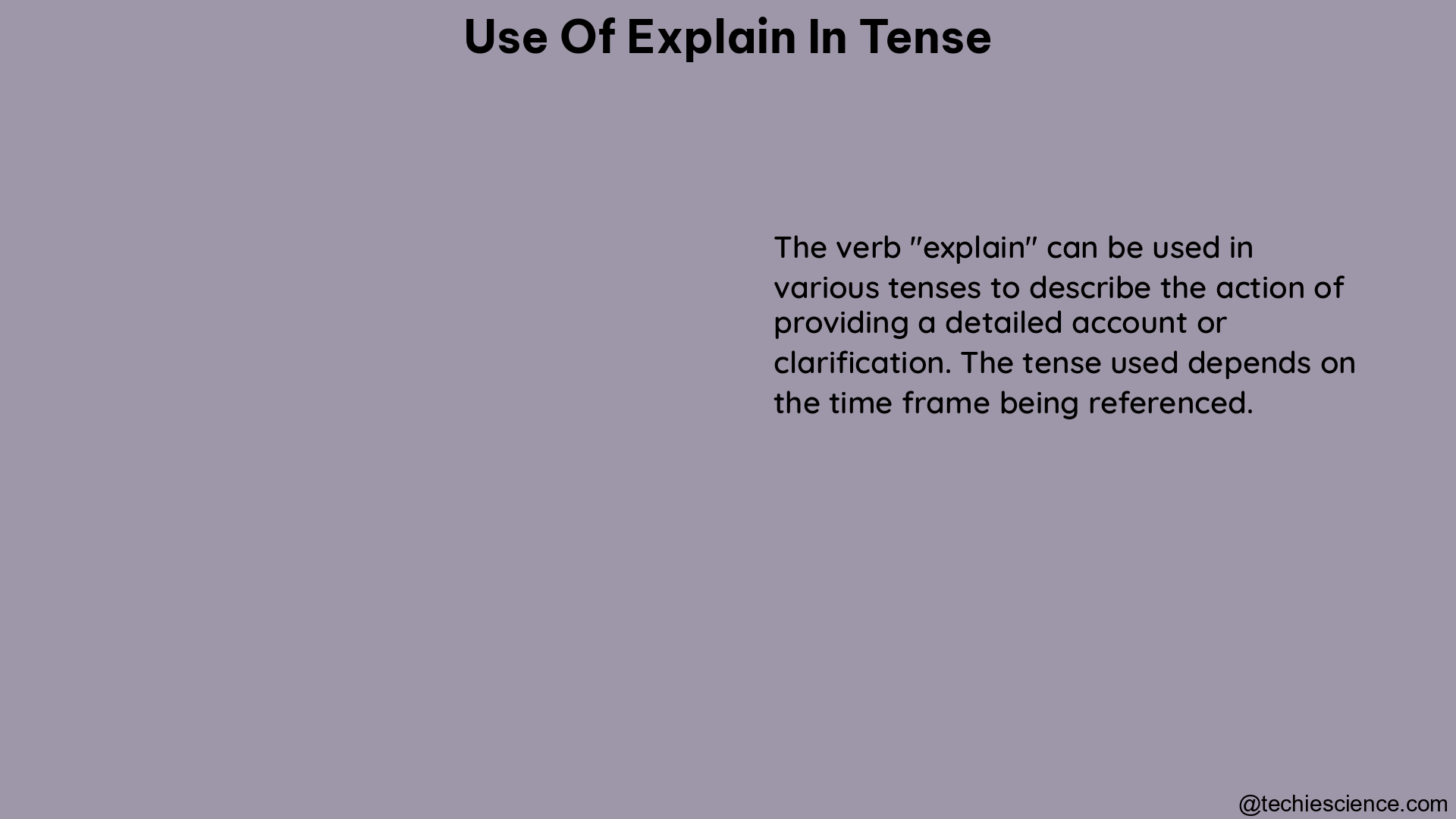The English language is a rich and complex tapestry, and the proper use of the verb “explain” is a crucial component of effective communication. Whether you’re a student, a teacher, or a professional, understanding the nuances of using “explain” in different tenses can elevate your language skills and help you convey your ideas with clarity and precision.
Present Tense
Simple Present
The simple present tense of “explain” is used to describe general truths or habitual actions. For example:
- “I explain the concept to my students every day.”
- “The teacher explains the assignment in detail before class.”
Present Continuous
The present continuous tense of “explain” is used to describe ongoing actions. For instance:
- “I am explaining the concept to my students right now.”
- “The professor is explaining the research methodology to the class as we speak.”
Present Perfect
The present perfect tense of “explain” is used to describe completed actions with a connection to the present. Consider these examples:
- “I have explained the concept to my students several times.”
- “The company has explained the new policy to all employees.”
Present Perfect Continuous
The present perfect continuous tense of “explain” is used to describe ongoing actions that started in the past and continue up to the present. For example:
- “I have been explaining the concept to my students for the past hour.”
- “The tutor has been explaining the math problem to the student for the entire session.”
Past Tense

Simple Past
The simple past tense of “explain” is used to describe completed actions in the past. Consider these examples:
- “I explained the concept to my students yesterday.”
- “The teacher explained the assignment in detail last week.”
Past Continuous
The past continuous tense of “explain” is used to describe ongoing actions in the past. For instance:
- “I was explaining the concept to my students when the bell rang.”
- “The professor was explaining the research methodology when the power went out.”
Past Perfect
The past perfect tense of “explain” is used to describe completed actions in the past before another action. For example:
- “I had explained the concept to my students before the test.”
- “The company had explained the new policy to all employees before the implementation date.”
Past Perfect Continuous
The past perfect continuous tense of “explain” is used to describe ongoing actions in the past that led up to another action. Consider these examples:
- “I had been explaining the concept to my students for an hour before the test.”
- “The tutor had been explaining the math problem to the student for the entire session before the exam.”
Future Tense
Simple Future
The simple future tense of “explain” is used to describe future actions. For instance:
- “I will explain the concept to my students tomorrow.”
- “The teacher will explain the assignment in detail next week.”
Future Continuous
The future continuous tense of “explain” is used to describe ongoing actions in the future. For example:
- “I will be explaining the concept to my students next week.”
- “The professor will be explaining the research methodology to the class throughout the semester.”
Future Perfect
The future perfect tense of “explain” is used to describe completed actions in the future. Consider these examples:
- “I will have explained the concept to my students by the end of the month.”
- “The company will have explained the new policy to all employees by the time the changes take effect.”
Future Perfect Continuous
The future perfect continuous tense of “explain” is used to describe ongoing actions in the future that will lead up to another action. For instance:
- “I will have been explaining the concept to my students for a month by the time the course ends.”
- “The tutor will have been explaining the math problem to the student for the entire session by the time of the exam.”
Special Cases
Explaining Pictures or Stories
When describing events depicted in pictures or stories, the past tense is often used to narrate the sequence of events. However, the present tense can also be used if the focus is on the current action in the picture.
Photo Captions
In photo captions, style guides for newspapers and other timely publications often mandate the use of the present tense, even when referring to past events. This helps to create a sense of immediacy and relevance for the reader.
Common Mistakes
Pronunciation
It’s important to ensure that the “e” at the end of “explained” is silent, as this is the standard pronunciation in English.
Word Order
When using “explain,” always remember to use “to” after the verb (e.g., “Can you explain this to me?”).
Avoiding “Explication”
In modern English, it’s generally better to use the word “explanation” instead of “explication,” as the latter is less common and may sound overly formal or academic.
References
- Preply. (2016). Past tense of explain | Learn English. Retrieved from https://preply.com/en/question/past-tense-of-explain
- Cambridge Dictionary. (n.d.). Explain – English Grammar Today. Retrieved from https://dictionary.cambridge.org/us/grammar/british-grammar/explain
- Stack Exchange. (2014). Which tense can we use to explain pictures? Retrieved from https://ell.stackexchange.com/questions/20586/which-tense-can-we-use-to-explain-pictures
- YouTube. (2018). English grammar with verbs: How to use the verb explain perfectly. Retrieved from https://www.youtube.com/watch?v=BCi5KMQ8q68
- WordHippo. (n.d.). What is the past tense of explain? Retrieved from https://www.wordhippo.com/what-is/the-past-tense-of/explain.html
Hey! I am Arpita Bose Roy. My qualifications are M.A. in English with B. Ed. in both general education and special education. I have 2 years of experience as a “language analyst” at IIT Kharagpur and 4 years of experience as an “Academic Content Developer” at IIT Kharagpur. Currently, I am working as an academic writer at Lambdageeks.